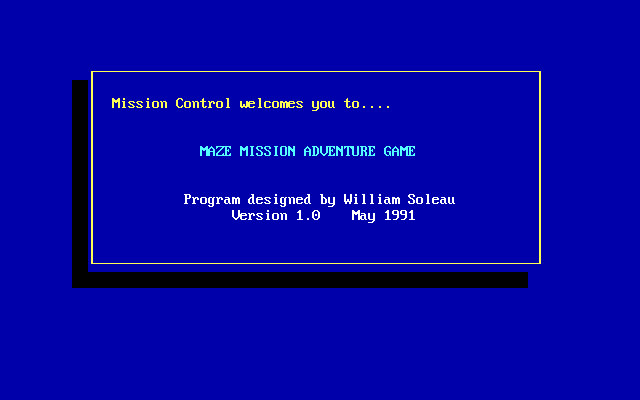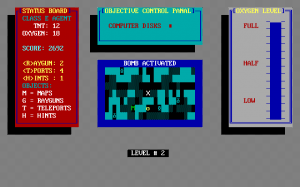Maze Mission Adventure Game 
William Soleau has had a steady output of shareware puzzle games since 1991. Quality of some of the games aside (see Ladder Man), this is an accomplishment in tenacity. If nothing else, Soleau Software is prolific.
Maze Mission Adventure Game may be one of his earliest; the game predates the Soleau Software brand. It’s clearly the work of a developer getting their bears. It’s riddled with typos and sits comfortably about five years behind graphics technology at at the time. But it’s pretty good. The game never progresses or goes anywhere, but it captures the fun of exploring and getting lost.
In MMAG, you play as an agent working for the enigmatic Mission Control. On each mission, you must locate stolen items that have been squirreled away in a deep cave. When you escape successfully, Mission Control will inevitably have another mission for you to pursue and more equipment for you to find.
Each cave is riddled with enemies and partially obstructed paths. You clear these out with rayguns and TNT respectively. You are free to explore the cave as you wish – and you’ll need to, given how little guidance you get to find each piece of equipment – but you need to refresh on oxygen as frequently as possible. TNT and oxygen are randomly scattered around, and if you pace yourself well, you could feasibly keep exploring the cavern maze as long as you continue picking up more items.
The gameplay is fairly well balanced. You can use hints to point you in the right direction towards the missing equipment, but additional hints are hard to find in the wild. Moving too fast will cause a cave-in, and it happens frequently enough to encourage you to stockpile TNT and to use it more sparingly. Enemies teleport you back to the start rather than hurting you, so the punishment is disorientation rather than lost progress. Plus, you can teleport yourself to a random spot should a difficult situation arise. Once you figure out the rhythm of the game, it is consistently fair.
After the first level, it doesn’t really go anywhere. Every subsequent stage is roughly the same deal with a different color scheme and minor variations. Like palette swaps in an old Nintendo game, the color changes do convey a new setting, but each stage is much like the last. It’s still a good time though. Stages are randomly generated, and it doesn’t get as old as quickly you would expect.
Maze Mission Adventure Game is simple fun for an ASCII game, nothing more and nothing less. The caves can be exciting to explore, and the game is evenly paced. I played this one for a surprisingly long time given how little long-run variety there is. The exploration formula works well in short bursts. By all appearances, Soleau got his formula right on his first game.



“Every subsequent stage is the same deal with a different color scheme.”
Actually not so. The number of objects varies, as does the amount of TNT you get per collectible. And each stage has a theme.
1 – balanced
2 – long thin passages
3 – big square passages
4 – only solid walls
5 – only destructible walls
6 – subdivided, must use teleports
“Stages are randomly generated, and it doesn’t get as old as quickly you would expect.”
The position of the bonus drops and enemies is random, but the basic walls are the same for each stage each time. Took me a surprisingly long amount of time to figure this out, but it’s a big help in winning with repeated plays.
Interesting! Thank you for sharing that. I didn’t notice the variations or lack of variations (especially in terms of level layouts staying similar). I’ve updated the article a bit to reflect that there’s some changes. I think this is one I need to rewrite in general…
Seems like I’ve been playing this game forever. From 1991 to 2024 is pretty much forever, but it’s around half my age. Thousands of games, all different due to the random nature of the drops and the cave-ins. I played it on my first IBM clone and on probably 20 computer upgrades. As computer resolution capabilities improve it seems that the app display size shrinks. My current 32″ monitor is 3840 x 2160
Can anyone tell me how to increase the app display size so I can now see what I’m doing. And don’t say you need better glasses. Already done that.